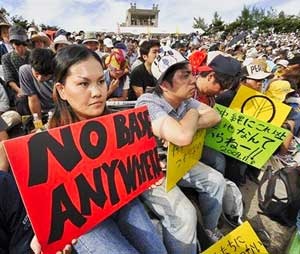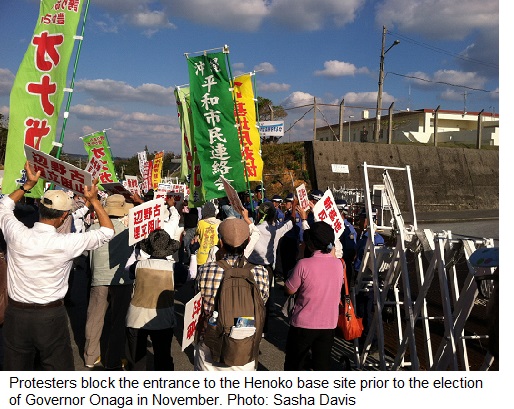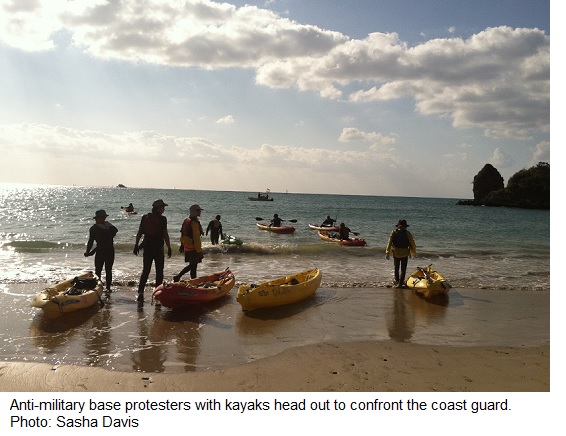 There is a showdown coming in Okinawa that will test the limits of US and Japanese state power.
There is a showdown coming in Okinawa that will test the limits of US and Japanese state power.
The construction of a new US Marine Corps airbase in the rural coastal village of Henoko has been controversial since it was proposed almost two decades ago. Events in the past two months however -including a protest by thousands of people surrounding the Japanese National Diet in Tokyo on January 25th – have heated the controversy to a boiling point. The military base is meant to be a replacement for the Futenma Marine Corps Air Station which most observers in Okinawa, Japan and the US recognize needs to be closed. Futenma, dubbed by Donald Rumsfeld as “the most dangerous base in the world,” sits squarely in the middle of crowded Ginowan City in central Okinawa. The problem with finding a “Futenma Replacement Facility” is that no place in the Asia-Pacific region has been willing to pay the political, social and environmental costs of hosting a new base. Because of this, a site had to be selected based not on where the base was wanted, but where resistance to the base could most easily be overcome. The Japanese and US governments agreed to select Henoko as the site for this replacement facility because the new base could be connected to the existing US property at Camp Schwab and because Henoko is the marginalized section of a marginalized municipality (Nago), in Okinawa -the most marginalized prefecture of Japan.
 Despite being in the periphery of Japanese political power, local political opposition, protests, and acts of civil disobedience have delayed base construction in Henoko for over ten years. This changed in December 2013 when Okinawa’s governor, Hirokazu Nakaima –originally elected in part due to his stated opposition to the base –capitulated to demands from Tokyo and approved permits to allow construction in Henoko. Since construction activities began in earnest this past year, however, Okinawans have become ever more adamant that their island of over a million people should not host another US military base. After Governor Nakaima’s change-of-heart, Okinawa has seen a string of resounding electoral defeats for any politician publically supporting the new base. The staunchly anti-base Susumu Inamine was elected as the mayor of Nago and then in November 2014, in an election widely seen as a referendum on the Henoko issue, governor Nakaima was defeated by Takeshi Onaga by almost 100,000 votes. Onaga, a member of the same conservative LDP party as Nakaima and Prime Minister Shinzo Abe, broke ranks and has said he will do “everything in my power” to stop the new base. Following this, in December of 2014, all four pro-base LDP candidates for the National Diet from Okinawa were defeated in local elections by anti-base opponents. The response from Washington and Tokyo has been frosty. Top officials in Tokyo refused to meet with Onaga on his recent visit to the capital and Tokyo has also slashed Okinawa’s budget by 5% in retribution for its opposition to the Henoko base.
Despite being in the periphery of Japanese political power, local political opposition, protests, and acts of civil disobedience have delayed base construction in Henoko for over ten years. This changed in December 2013 when Okinawa’s governor, Hirokazu Nakaima –originally elected in part due to his stated opposition to the base –capitulated to demands from Tokyo and approved permits to allow construction in Henoko. Since construction activities began in earnest this past year, however, Okinawans have become ever more adamant that their island of over a million people should not host another US military base. After Governor Nakaima’s change-of-heart, Okinawa has seen a string of resounding electoral defeats for any politician publically supporting the new base. The staunchly anti-base Susumu Inamine was elected as the mayor of Nago and then in November 2014, in an election widely seen as a referendum on the Henoko issue, governor Nakaima was defeated by Takeshi Onaga by almost 100,000 votes. Onaga, a member of the same conservative LDP party as Nakaima and Prime Minister Shinzo Abe, broke ranks and has said he will do “everything in my power” to stop the new base. Following this, in December of 2014, all four pro-base LDP candidates for the National Diet from Okinawa were defeated in local elections by anti-base opponents. The response from Washington and Tokyo has been frosty. Top officials in Tokyo refused to meet with Onaga on his recent visit to the capital and Tokyo has also slashed Okinawa’s budget by 5% in retribution for its opposition to the Henoko base.
The recent elections, however, are only part of the story of the hardening of public sentiment in Okinawa. Protests, and the government responses against them, have also escalated. Protests against bases have been going on in Henoko, as well as near other bases in Okinawa, for decades, but the protests are starting to change. The protests have often been somewhat polite affairs. Before the elections in November, people protesting in Henoko would dance, chant, hold placards and sing in front of the gates. Then when a vehicle needed access to the base site, the protesters would move to the side while police escorted vehicles through the parted crowd. Meanwhile, in the sea surrounding Henoko the Japanese Coast Guard played cat-and-mouse with protestors in kayaks that would paddle through a zone in the bay recently declared to be off-limits.
The protests are now different. As can be seen in many places around the world, when the will of a people has been unequivocally expressed and a government insists on doing things against popular wishes anyway, protests become more confrontational and heated. In the face of Washington and Tokyo’s steadfast insistence the base be built in Henoko – regardless of Okinawan public opinion – the protesters have realized that elections may not be enough to stop the base. The human blockades are turning tense. To avoid protesters, construction trucks now attempt to enter at night. Protesters have matched this with late night blockades of the entrance and now people are no longer moving aside when asked. Shortly after midnight on January 11th, police scuffled with protesters who were attempting to block the entrance of construction vehicles. One protester was hospitalized.
 Given the overwhelming opposition in Okinawa to the new base (recent polls put public support for its construction at about 15%) the US and Japanese governments would be wise to withdraw the plan to construct the base at Henoko. Instead, both governments are pressing ahead. Counter to the axiom that “all politics are local” these governments continue to profess that agreements between the Japanese and US central governments are all that matter on military issues. Emblematic of this is a statement made by US Lieutenant General Keith J. Stalder (Commander of Marine forces in the Pacific) after the election of an anti-base mayor in Nago in 2010. He stated flatly that “National security policy cannot be made in towns and villages.” General Stalder – and others in the US and Japanese governments – need to realize, however, that this statement is dead wrong. Local support is crucial to maintaining functioning bases because there are unavoidable negative environmental, health and safety issues that occur to people that are living next to them: planes are loud (especially the tilt-rotor “Osprey” aircraft that have recently been deployed to Okinawa despite massive local protests), helicopters crash into college campuses (as occurred in 2004 next to Futenma MCAS at Okinawa International University), live bombs used in training go off target and kill people (as happened in Vieques, Puerto Rico in 1999), landscapes can be eroded and contaminated (such as occurred to the island of Kaho’olawe in Hawai’i for decades), and access to natural and cultural resources can be lost (which is slated to occur if plans for a live-fire range in Pagat or Ritidian on Guam continue as scheduled). For all of these reasons, local politics matter when it comes to military bases. In fact, all of the above examples come from places where local protests have caused military bases or training areas to be either closed (Kaho’olawe and Vieques), put under pressure to close (Okinawa’s Futenma MCAS) or blocked from expanding (Pagat, Guam).
Given the overwhelming opposition in Okinawa to the new base (recent polls put public support for its construction at about 15%) the US and Japanese governments would be wise to withdraw the plan to construct the base at Henoko. Instead, both governments are pressing ahead. Counter to the axiom that “all politics are local” these governments continue to profess that agreements between the Japanese and US central governments are all that matter on military issues. Emblematic of this is a statement made by US Lieutenant General Keith J. Stalder (Commander of Marine forces in the Pacific) after the election of an anti-base mayor in Nago in 2010. He stated flatly that “National security policy cannot be made in towns and villages.” General Stalder – and others in the US and Japanese governments – need to realize, however, that this statement is dead wrong. Local support is crucial to maintaining functioning bases because there are unavoidable negative environmental, health and safety issues that occur to people that are living next to them: planes are loud (especially the tilt-rotor “Osprey” aircraft that have recently been deployed to Okinawa despite massive local protests), helicopters crash into college campuses (as occurred in 2004 next to Futenma MCAS at Okinawa International University), live bombs used in training go off target and kill people (as happened in Vieques, Puerto Rico in 1999), landscapes can be eroded and contaminated (such as occurred to the island of Kaho’olawe in Hawai’i for decades), and access to natural and cultural resources can be lost (which is slated to occur if plans for a live-fire range in Pagat or Ritidian on Guam continue as scheduled). For all of these reasons, local politics matter when it comes to military bases. In fact, all of the above examples come from places where local protests have caused military bases or training areas to be either closed (Kaho’olawe and Vieques), put under pressure to close (Okinawa’s Futenma MCAS) or blocked from expanding (Pagat, Guam).
In these places citizens have come to view military activities not as enhancing their security, but rather as threats to their security. This is an especially prevalent concern in Okinawa where citizens shoulder a disproportionate burden of hosting US bases in Japan (over 70% of US bases in Japan are in tiny Okinawa). Furthermore, the population has a unique historical perspective on militarization. Older generations of Okinawans still have living memory of the bloody 1945 Battle of Okinawa. In this battle between the Japanese and US militaries the recently colonized Okinawans were caught between the two empires and over 100,000 civilians were killed. This battle serves as a reminder that being someone else’s militarized fortress does not make you safe, it makes you a target. This is a lesson many Okinawans have not forgotten, even if the US and Japanese governments wish they would.
Sasha Davis is an Assistant Professor of Geography and Environmental Science at the University of Hawaii-Hilo and the author of “The Empires’ Edge: Militarization, Resistance and Transcending Hegemony in the Pacific.”
